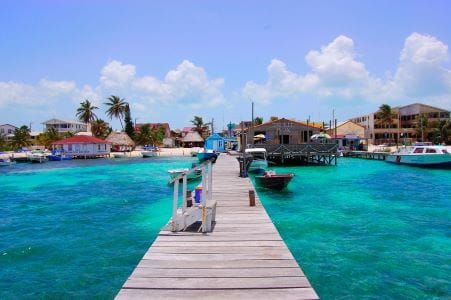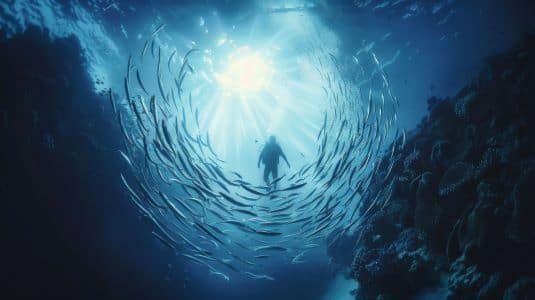When you think of diving in Belize, the Blue Hole probably jumps to mind first. Yes, it’s famous for a reason – its near-perfect circular form, its plunging blue depths. But Belize isn’t a one-dive wonder. Beyond the brochures and Instagram shots, Belize holds a marine world brimming with complexity, color, and charisma. This isn’t a place you come to tick off a dive site. It’s a place you come to stay in the water.
Let’s dive deeper, literally and figuratively, into what makes this Central American dive gem a world-class (but still surprisingly under-the-radar) destination for divers.
Not Just the Barrier Reef: a Labyrinth of Underwater Habitats

Belize boasts the second-largest barrier reef in the world. That’s a big headline, but what doesn’t get mentioned enough is how incredibly varied the diving is here. The reef isn’t one endless stretch, it’s a constantly changing ecosystem of walls, pinnacles, overhangs, and tunnels. Add to that 3 atolls- Turneffe, Lighthouse, and Glover’s Reef – and you suddenly have access to deep walls, pristine coral gardens, and high-voltage drift dives, often within a day’s range.
Spotted eagle rays glide past as you descend along vertical walls draped in sea fans. Nurse sharks circle lazily beneath you. Schools of horse-eyed jacks flash silver in the sunlight while damselfish dart around like sparks. The water is consistently warm, the visibility often surpasses 30 meters, and the marine life seems unaware that you’re not just another curious fish.
Turneffe Atoll: The Reef System That Hides in Plain Sight
Lighthouse Reef gets the attention (thanks, Blue Hole), but Turneffe Atoll might be the most quietly spectacular part of Belize’s underwater world. It’s the largest and most biologically diverse of the 3 atolls. At sites like The Elbow, you’re in for a high-speed drift dive teeming with large pelagics, groupers, tarpon, and the occasional reef shark.
But what really makes Turneffe special is the microhabitat diversity. Mangroves lead into seagrass beds that are home to dugongs, which then melt into coral reefs. You can spot seahorses, jawfish, and batfish on a single dive. It’s the kind of place where photographers find themselves torn between macro and wide-angle lenses on the same tank.
Living at Sea: Why a Liveaboard Changes Everything
If you’ve only dived from shore or day boats, Belize’s liveaboard scene opens up a new way to experience its aquatic wilderness. Forget gear schlepping. Forget surface intervals on a crowded beach. On a liveaboard, you eat, sleep, and breathe diving. You also reach sites few others can, at times when nobody else is there.
The Belize Aggressor IV, for instance, spends a week, hopping between Turneffe Atoll and Lighthouse Reef. One moment you’re waking up to sunrise over Half Moon Caye; the next, you’re slipping into the water before breakfast for a private showing of a world-class dive site. Night dives are a regular part of the itinerary, bringing squid, octopuses, and the eerie glow of bio-luminescent plankton into your orbit.
There’s something strangely addictive about the rhythm of a liveaboard: dive, eat, dive, nap, dive, eat, dive, stargaze, repeat. After a week, land feels like an unnecessary complication.
Beyond Fish: Diving with Purpose in Belize

Many liveaboard operators and local dive resorts in Belize are becoming more engaged with conservation-minded diving. Projects range from lionfish hunting (yes, you can spear an invasive species for dinner) to coral nursery visits, and even REEF fish surveys for citizen scientists.
Belize was the first country in the world to ban bottom trawling and offshore oil drilling near its barrier reef. That’s not a marketing slogan, it’s a testament to how this small nation views its marine treasure: not as a commodity, but as a living, breathing inheritance.
When you dive here, you’re not just exploring, you are participating in a shared act of preservation. And divers who come here often return again and again, drawn not just by the beauty of the sites but by the sense that what they do underwater actually matters.
Off the Radar: Sites You Won’t Find in a Travel Brochure
You won’t find names like Tres Cocos, Tunnels of Love, or The Aquarium on the front pages of dive magazines, but local divemasters know them well. These hidden gems, often accessible only by smaller boats or liveaboards, reward curiosity with dramatic terrain and close encounters. Schools of snapper weaving through crevices, solitary hammerheads cruising by in the blue, and coral formations that look sculpted rather than grown.
Ask around. Belize’s best dives aren’t always marked with a buoy, they’re shared by word of mouth.
Final Descent: More Than a Dive Trip
A scuba diving trip in Belize isn’t just a vacation, it’s an immersion, not just in warm water, but in an ecosystem of stunning complexity and rare access. The reefs are healthy, the crowds are (still) thin, and the liveaboard and resort options let you dive deeper into the true pulse of the Caribbean.
So if your idea of a perfect dive trip isn’t about ticking off the usual ‘top 10’ sites, but about discovering something deeper, quieter, and more alive, then maybe it’s time to stop chasing the next big destination and start diving Belize on its own terms.
Maire Brown